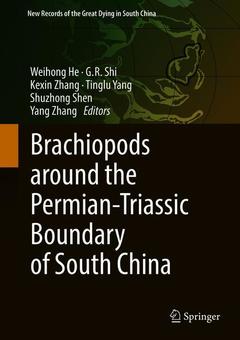Description
Brachiopods around the Permian-Triassic Boundary of South China, 1st ed. 2019
New Records of the Great Dying in South China Series
Coordinators: He Wei-Hong, Shi G. R., Zhang Ke-Xin, Yang Ting-Lu, Shen Shu-Zhong, Zhang Yang
Language: English
Subject for Brachiopods around the Permian-Triassic Boundary of...:
Support: Print on demand
Description
/li>Contents
/li>Biography
/li>Comment
/li>
This timely book documents marvelous brachiopod fossils from the Palaeozoic-Mesozoic transition of South China. Numerous beautiful pictures and detailed descriptions (specifically the measurements of body size) of brachiopod species are presented. Systematic discussion on the evolution of brachiopod biodiversity and morphological features across the critical interval is not only extremely important for paleontologists to understand the marine ecosystem evolution from the Palaeozoic to the Mesozoic, but also attractive for students who need to know about the end-Permian mass extinction.
The book distinguishes itself from other studies by its detailed study of the taxonomy, biodiversity and paleoecology of Permian-Triassic brachiopods from different palaeogeographic facies, especially from the deep-water environment in South China. The book also offers a unique study of the response of morphological features of brachiopods to palaeoenvironmental changes, providing insights for the process of Permian-Triassic crisis.
Introduction: HE Weihong, SHI GR, SHEN Shuzhong.- Geographical location and palaeogeographic setting of studied sections: HE Weihong, ZHANG Kexin, SHI GR.- Depositional sequences, biotic assemblages and review on Changhsingian (or late Changhsingian) palaeo-water depths of studied sections: HE Weihong, ZHANG Kexin, SHI GR, XIAO Yifan, BU Jianjun.- Age analysis and stratigraphic correlation: HE Weihong, SHI GR, ZHANG Kexin, WU Shunbao.- Materials and methods: HE Weihong, SHI GR, YANG Tinglu, WANG Yongbiao.- Evolution of brachiopod diversity across the PTB in varied palaeogeographic settings: HE Weihong, SHI GR.- Spatial and temporal body-size changes of brachiopods in relation to varied palaeogeographic settings: HE Weihong, SHI GR.- Discussion on changes of brachiopod diversity and morphologic features and their implications for the environmental crisis of the Great Dying: HE Weihong, SHI GR, BU Jianjun.- Systematic Palaeonology:HE Weihong, SHI GR, SHEN Shenzhong, YANG Tinglu, ZHANG Yang, WU Huiting, WANG Han, BU Jianjun.
Prof. Weihong He works at the State Key Laboratory of Biogeology and Environmental Geology and School of Earth Sciences, China University of Geosciences, Wuhan, China. Her research interests include Permian-Triassic brachiopods, radiolarians, bivalves, cephalopods, paleoecology and paleoenvironment. She is the winner of the Endeavour Research Fellowship awarded by Australia Government in 2009, the Winner of Education Ministry's New Century Excellent Talents Supporting Plan in 2010 and has the title of Provincial Young and Middle-aged Expert with Outstanding Contributions. She has published more than 90 papers in many peer-reviewed journals as the main author or co-author, covering Journal of Systematic Palaeontology, Journal of Paleontology, as well as Geobiology.
Prof. GR SHI works at Deakin University, Australia, where he was Personal Chair in Palaeontology and Head of School of Life and Environmental Sciences for years. He has been bestowed the title of Alfred Deakin Professor by the University Council recently. His research interests includes Permian Brachiopod, Stratigraphy and Palaeobiogeography. He has served as President of Association of Australasian Palaeontologists and also served as the lead chief investigator of 5 Australian Research Council (ARC) Discovery Project grants and a number of other national and international competitive research grants. He has published over 200 peer-reviewed scientific papers, including in Journal of Paleontology, Geobiology, as well as Palaeogeography, Palaeoclimatology, Palaeoecology.
Prof. Kexin Zhang is now Professor at China University of Geosciences, Wuhan. His research interests involve Micropaleontology (conodont), Stratigraphy, Sedimentary, Cenozoic uplift of the Tibet Plateau. He has won National Science and Technology Award in 2002 and Special Award of the National Science and Technology Progress Award in 2011. As one of major authors, He firstly proposed the conodont Hindeodu




